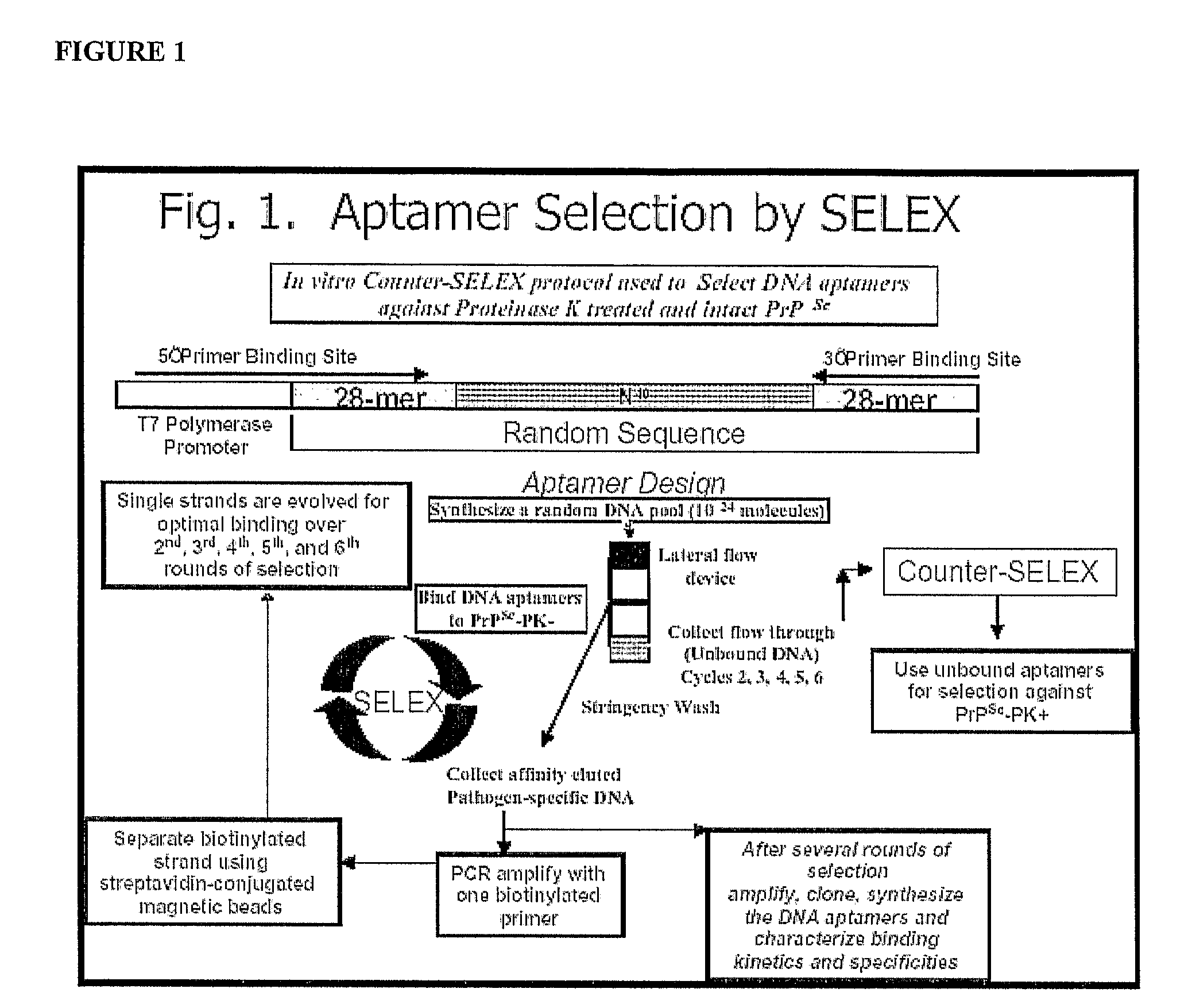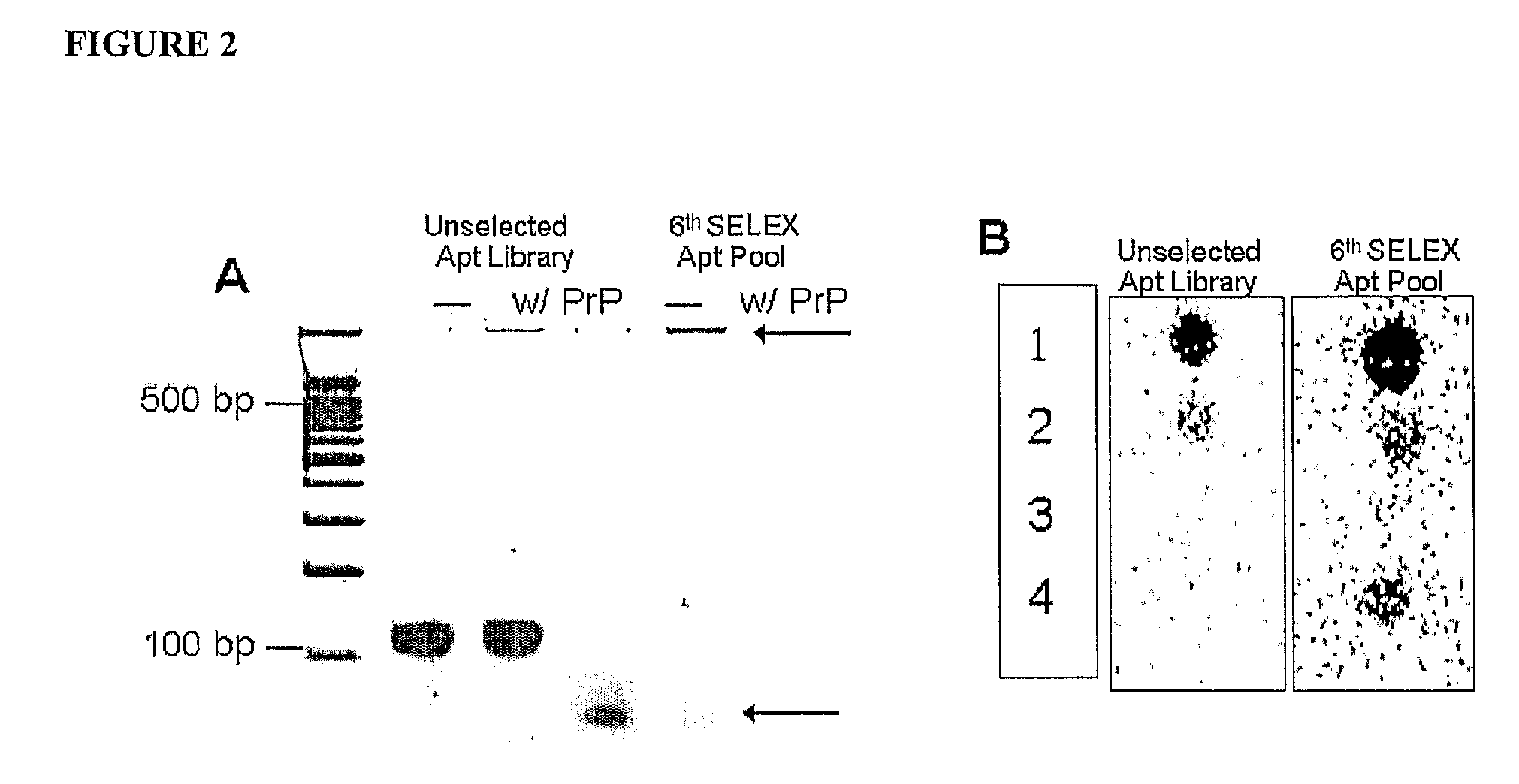Aptamers that bind to prion protein
a technology of prion protein and aptamers, applied in the field of aptamers that bind to prion protein, can solve problems such as ineffective treatmen
- Summary
- Abstract
- Description
- Claims
- Application Information
AI Technical Summary
Benefits of technology
Problems solved by technology
Method used
Image
Examples
example 1
Preparation of Aptamers that Distinguish Between Prion Isoforms
[0036]DNA aptamers were selected against rhuPrP via the SELEX procedure, using lateral flow chromatography. We generated a panel of DNA aptamers that bind to recombinant PrPC and immunoprecipitated mammalian PrPC derived from a variety of animal species. Further, these DNA aptamers did not bind to PrPSc and other neuroproteins.
[0037]Materials and Methods
[0038]Materials for SELEX. An aptamer library was synthesized (Integrated DNA technology, Inc., Coralville, Iowa) that consisted of a randomized 40-mer DNA sequence flanked by two known 28-mer primer-binding sites:
[0039](59-TTTGGTCCTTGTCTTATGTCCAGAATGC-N40-ATTTCTCCTACTGGGATAGGTGGATTAT-39: where N40 represents 40 random nucleotides with equimolar A, C, G, and T)
[0040]The same manufacturer was used to synthesize all primers and aptamers applied in this study. The rhuPrPC fragment consisting of amino acid residues 23-231 (rhuPrPC23-231) served as the target protein. A device...
example 2
Counter-SELEX
[0070]Materials for SELEX—An aptamer library that consisted of a randomized 40-mer DNA sequence flanked by two known 28-mer primer binding sites (5′-TTTGGTCCTTGTCTTATGTCCAGAATGC-N40
[0071]-ATTTCTCCTACTGGGATAGGTGGATTAT-3′: where N40 represents 40 random nucleotides with equimolar A, C, G and T) was synthesized (Integrated DNA technology, Inc., Coralville, Iowa. The same manufacturer was used to synthesize all primers and aptamers applied in this study). Drowsy strain of PrPSc fragment consisting of amino acid residue 23 to 231 (Proteinase K untreated—PK−) and 90-231 (Proteinase K treated—PK+) served as target proteins. A device for lateral flow chromatography (6 mm×65 mm) consisting of a nitrocellulose (NC) membrane immobilized on a polymer support with aptamer releasing pad at one end and wicking pad at the other, was used as the solid phase support for SELEX procedures.
[0072]SELEX and synthesis of selected aptamers—The aptamer library was enriched for the selection of s...
example 3
Gel-Shift Analysis of Aptamers Selected Against PrPSc
[0074]We evaluated the binding specificities of aptamer pools, after 8 rounds of SELEX, against PrPSc and PrPC molecules using gel-shift analyses.
[0075]Materials and Methods
[0076]Gel-Shift Analysis: Synthesized aptamers or heat-denatured amplicons of the 8th SELEX derived aptamer pool were incubated with rhuPrPc23-231, rhu90-231, hamster drowsy PrPSc-PK+ or hamster drowsy PrPSc-Pk− for 30 min at room temperature. The mixture was resolved by 1× Tris-Borate-EDTA (TBE) buffered native polyacrylamide gel electrophoresis. The amplicons of the 10th aptamer pool were visualized by ethidium bromide staining. The synthesized aptamers were transferred onto a positively charged nylon membrane (Schleicher & Schuell Inc., Keene, N.H.). The nylon membrane was blocked with 0.2% Blocking Reagent (Roche Diagnostics Co., Indianapolis, Ind.) in PBST followed by incubation with streptavidin-alkaline phosphate conjugate (Promega, Madison, Wis.). The n...
PUM
 Login to View More
Login to View More Abstract
Description
Claims
Application Information
 Login to View More
Login to View More - R&D
- Intellectual Property
- Life Sciences
- Materials
- Tech Scout
- Unparalleled Data Quality
- Higher Quality Content
- 60% Fewer Hallucinations
Browse by: Latest US Patents, China's latest patents, Technical Efficacy Thesaurus, Application Domain, Technology Topic, Popular Technical Reports.
© 2025 PatSnap. All rights reserved.Legal|Privacy policy|Modern Slavery Act Transparency Statement|Sitemap|About US| Contact US: help@patsnap.com



